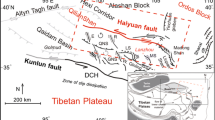Abstract
Hydrogen gas can be released by chemical and mechanical changes in crustal rocks. Once released, it is highly mobile, buoyant, and almost insoluble in groundwater. A fault system may act as a conduit, allowing hydrogen to accumulate in soil gases near a surface expression. Since hydrogen is scarce in ambient air, its presence at elevated levels in soil gases may be a tool for fault mapping. In order to evaluate this tool, we surveyed eleven different faults by measuring the concentration of hydrogen and methane in 2 to 21 soil-gas samples that were collected near each of them. The sense of motion at four of those faults is normal (western United States, Greece), at five it is strike-slip or dip-slip (California, Colorado, Japan), and at two it is thrusting (California). At four of these faults (Hebgen Lake, Yellowstone, Yamasaki, Burro Mountain) maximum concentrations of hydrogen ranged from 80 ppm to 70% and methane from 300 ppm to 5%. All other sites showed ambient levels of both gases, except for one sample taken at Mt. Borah, Idaho, that was 2% methane. From this preliminary study it is not clear whether the presence of hydrogen is correlated uniquely to the location of faults or whether it occurs randomly. The conditions required to produced and accumulate hydrogen are also not clear. Excess hydrogen may well be produced by different mechanisms in different geological regimes. For example, if ferrous hydroxide is present in local rocks, it may react to produce hydrogen. Detailed and extensive studies are needed to clarify the connection between hydrogen and tectonic faulting.
Similar content being viewed by others
References
Barnes, I., Rapp, J. B., andO'Neil, J. R. (1972),Metamorphic Assemblages and the Direction of Flow of Metamorphic Fluids in Four Instances of Serpentization, Contr. Mineral. and Petrol.35, 263–276.
Evans, W. C. (1984), private communication.
Giardini, A. A., Subbarayudu, G. V., andMelton, C. E. (1976),The Emission of Occluded Gas From Rocks as a Function of Stress: Its Possible Use as a Tool for Earthquake Prediction, Geophys. Res. Lett.3, 355.
Gold, T., andSoter, S. (1980),The Deep Earth Gas Hypothesis, Sci. Am.242, 154.
Jiang, F. L., andLi, G. R. (1981),Experimental Studies of the Mechanisms of Seismogeochemical Precursors, Geophys. Res. Lett.8, 473.
King C. Y. (1980),Episodic Radon Changes in Subsurface Soil Gas Along Active Faults and Possible Relation to Earthquakes, J. Geophys. Res.85, 3065.
Kita, I., Masuo, S., andWakita, H. (1982),H 2 Generation by Reaction between H 2 O and Crushed Rock—An Experimental Study of H 2 Degassing From the Active Fault Zone, J. Geophys. Res.87, 10789.
Kita, I., Matsuo, S., Wakita, H., andNakamura, Y. (1980),D/H Ratios of H 2 in Soil Gases as an Indicator of Fault Movements, Geochem. J.14, 317.
McGee, K. A., Casadevall, T. J., Sato, M., Sutton, A. J., andClark, M. d. (1982),Hydrogen Gas Monitoring at Long Valley Caldera, California, USGS Open-File Report 82-930.
McGee, K. A., Sutton, A. J., andSato, M. (1983),Correlations of Hydrogen Gas Emissions and Seismic Activity at Long Valley Caldera, California, EOS,45, 891.
Phillips, M. P., Sievers, R. E., Goldan, P. D., Kuster, W. C., andFehsenfeld, F. C. (1979),Enhancement of Electron Capture Detector Sensitivity to Non-Electron Attaching Compounds by Addition of Nitrous Oxide to the Carrier Gas, Analyt. Chem.51, 1819.
Sato, M., andMcGee, K. A. (1982),Continuous Monitoring of Hydrogen in the South Flank of Mt. St. Helens, USGS Prof. Paper 1250.
Sato, M., McGee, K. A., Sutton, A. J., andCasadevall, T. J. (1983),Continuous Hydrogen Monitoring for Predicting Earthquakes, EOS45, 758.
Sievers, R. E., Phillips, M. P., Barkley, R. M., Wizner, M. A., Bollinger, M. J., andHutte, R. S. (1979),Selective Electron Capture, J. Chromatography12, 3.
Sugisaki, R., Anno, H., Adachi, M., andUi, H. (1980),Geochemical Features of Gases and Rocks Along Active Faults, Geochem. J.14, 101.
Sugisaki, R., Ido, M., Takeda, H., Isobe, Y., Hayashi, Y., Nakamura, N., Satobe, H., andMizutani, Y. (1982),Origin of Hydrogen and Carbon Dioxide in Fault Gases and its Relation to Fault Activity, Chem. Geol.36, 217.
Wakita, H., Nakamura, Y., Kita, I., Fuji, N., andNotsu, K. (1980),Hydrogen Release: New Indicator of Fault Activity, Science210, 188.
Wakita, H., personal communication (1984).
Author information
Authors and Affiliations
Rights and permissions
About this article
Cite this article
Ware, R.H., Roecken, C. & Wyss, M. The detection and interpretation of hydrogen in fault gases. PAGEOPH 122, 392–402 (1984). https://doi.org/10.1007/BF00874607
Received:
Revised:
Accepted:
Issue Date:
DOI: https://doi.org/10.1007/BF00874607




